Developing innovative solutions to respond to rail business needs
Posted: 6 September 2019 | Bertrand Houzel, Global Railway Review, Jennifer Rezé (DGEX Solutions), Loic Hamelin (DGEX Solutions) | No comments yet
How and why does DGEX Solutions design innovative and resilient rail transport systems for its customers? Colleagues Bertrand Houzel, Loic Hamelin and Jennifer Rezé explain more.


What is the history behind DGEX Solutions?
Bertrand Houzel: To rise to the standards expected by our clients in terms of operational performance, especially for mass transit, innovative tools were needed for our teams in the field. In this context, DGEX Solution was created as a specific division within SNCF Réseau. From a small team in the beginning, DGEX Solutions has now expanded to over 100 collaborators who develop, optimise and create the right tools to improve the way we will run trains of tomorrow…starting now!
Thanks to a strong bond with the field, DGEX Solutions has gradually built a software ecosystem that strives to master the railway production process, be it preoperational or for real-time operations.
At an upstream stage, the software helps design the right sized infrastructure, optimise the track occupancy in stations and reduce the impact of structural engineering work of the schedule.
For real-time, DGEX Solutions creates tools that help anticipate and supervise the smooth running of operations. The whole ‘life’ of a commercial train is monitored from the elementary maintenance operation on a trainset, to its departure from the depot and its integration in a major hub. In case of disruption, these tools help guarantee operational robustness by alerting the operators and suggest optimal solutions.
To help us achieve this, we foster our relations with research through specific partnerships with schools and labs.
The next step we hope to take is towards our fellow network operators across Europe.
What are the main benefits of DGEX Solutions’ innovations and tools for the rail industry, and what level of feedback have your customers already given?
Bertrand Houzel: Predicting the value created by our solutions is a new subject for us on which we’ve been working this summer. To help us, we’ve been interviewing our customers to try and identify with them the specific gains we’ve helped them obtain. For example, after using OPEN GOV in Paris Saint Lazare, which is the biggest station in France in terms of suburban passengers, they claim to have gained up to two to three points in origin punctuality inducing a greater regularity for the Normandy and suburban lines. Another example in our digital ecosystem is OPEN TCO which uses image recognition to analyse the use of an existing infrastructure. It helps us rationalise the creation of future infrastructures as part of the renewal of signal cabins. In one the hubs in the south east of Paris (Villeneuve Saint Georges), it enabled the economy of the automation of two points and their maintenance in the years to come.
Implementing these tools is also a means of bringing together the different teams which contribute to the railway production in one station or production area.
Basically, our solutions aim to optimise the railway system on a whole: From our infrastructure (be it main line, in the stations or in the maintenance centres) to our rolling stock and personnel roasters.
Can DGEX Solutions’ innovations and tools be tailored to suit different customer requirements?
Jennifer Rezé: This is exactly the way we’ve been developing our tools from the start. We like to work hand in hand with operations and the users, spend time in the field to really understand the way people work and what their needs are. Once we have developed the tool on several sites with all their specificities we then try and merge in order to offer a consolidated version for industrialisation. In any case, even if new users have new needs we always try and fit them in because it usually is an evolution that will serve the others…only they don’t know it yet!
To what extent would you say DGEX Solutions is being proactive in making the rail sector an attractive career option for the next generation of engineers?
Jennifer Rezé: Our department is attracting a new range of students that SNCF Réseau couldn’t capture previously by offering them practical operational research problems to solve. Because we have quite a lot of ties with engineering schools and research labs, a lot of students go back and forth between their university and SNCF Réseau…but in the end they tend to stay on.
We also offer opportunities for candidates from operations to play a part in the digital revolution of rail, all thanks to our field experience and skills.
In your opinion, how will digitalisation and advances in technology further disrupt the rail industry and is DGEX Solutions ready to meet future challenges?
Loic Hamelin: In some ways we haven’t even thought of that yet and that is the beauty of it. How do we profoundly rethink the way our schedules are built with more optimisation and robustness? What makes a rail knot efficient? How to predict train delays? How do we minimise delays in case of disruption and offer almost instantaneous information to our passengers or clients? These are all thrilling subjects we are currently working on.
Biographies














